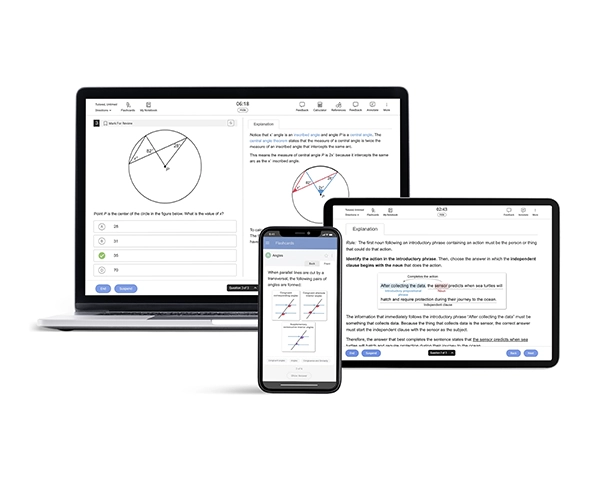Creating an SAT® test plan will help you keep track of the registration and exam dates, submission deadlines for college applications, and even help you create a study plan. So let’s take a look at how to plan for the SAT test with a few simple points to remember.
Registration
To register for the SAT® exam, you need to create an account with the College Board® or register by mail. However, the fastest way to register for the SAT exam is through the College Board website. You can find a schedule of test dates and deadlines on the College Board website.
Remember to schedule a test date that will give you enough time to prepare for the exam, and be sure to register for the SAT test before the registration deadline. You may also consider scheduling your first attempt at the SAT exam with time to have a second attempt.
Many students will register to take the exam during the spring semester of their junior year of high school. Just remember to be sure that you give yourself plenty of time to study and prepare without risking being late in sending your results for college application submissions. Test results usually take a few weeks to be released, so set yourself up for success by allowing lots of room around important deadlines. If you register after the deadline, you will have to pay a late registration fee.
Get Comfortable
After you have selected a test date and registered for the test, the next step is to get comfortable with the structure and format of the SAT exam. The SAT exam will assess your skills through Reading, Writing, and Math exams. This should be a key part of your SAT test plan.
The first section of the SAT test is the Reading exam. You will have sixty-five minutes to complete fifty-two multiple-choice questions. Questions that fall within these categories include: big picture, inference, words in context, evidence support, little picture, function, author technique, and analogy.
There are several topics covered in the passages throughout the Reading test. The overarching subjects for passages are literature, social science, science passages, and history. Expect each passage to be about 500 to 750 words. Some passages are accompanied by a graphic that you will need to evaluate or draw connections to the statements or opinions made in the passage.
The second section of the SAT test is the Writing exam. The SAT Writing test assesses your skills with grammar rules. You will encounter questions that ask you to spot and improve errors with these topics: wordiness, word choice, run-on sentences, sentence fragments, pronoun case, pronoun agreement, subject-verb agreement, parallelism, idioms, faulty modifiers, relative pronouns, adjectives, adverbs, verb tense, and verb form. You will have thirty-five minutes to complete forty-four multiple-choice questions that fall into the categories mentioned above.
The third section of the SAT exam is the Math test. This test assesses your performance with linear equations, inequalities, systems of linear equations, linear functions, ratios, percentages, rates, nonlinear expressions, quadratic equations, word problems, and complex functions. The first part of the Math test does not allow a calculator. So take time while preparing to acquaint yourself with solving simple mathematical calculations without the aid of a calculator.
You will have twenty-five minutes to answer the twenty no-calculator questions. You will then have a five-minute break before starting the section that allows a College Board-approved calculator. You will be given fifty-five minutes to answer the next thirty-eight calculator questions.
Most of the math questions are multiple-choice, but some of the questions are structured as grid-ins. To answer a grid-in-style question, you will need to write out your own answer. You must write and bubble in for the grid-in-style questions that will come up in both sections of the Math exam.
Once you understand what to expect from the structure of the SAT exam, you can figure out how to plan for the SAT test efficiently by focusing enough time on sections that need the most attention.
Gain Experience
The best way to gain experience with the SAT exam is through practice tests. Allotting enough time to take practice tests at regular intervals during prep should be an integral part of your SAT test plan. Tracking your performance on practice tests can create a valuable baseline for your study plan. Take practice exams to develop reasonable expectations and set goals for improvement within each section of the SAT exam.
Set Goals
It is important to set a target score and focus your time on the weakest areas of your score report. This part of your planning requires some research. It helps to look into the data about previously accepted students to determine what scores resulted in acceptances from your prospective colleges. While a comprehensive view of your application is ideal, top schools and schools with larger applicant pools may have stricter qualifications when it comes to the significance of your SAT scores.
For larger colleges that have massive applicant pools, a comprehensive view of each application is impossible. In such cases, admissions can use scoring data to decide who makes it through the initial admissions process. Top universities and colleges will use test scores and GPAs to filter out applicants who do not fit their specific requirements. In this case, to be considered by admissions, you will have to reach a specific score or GPA.
The best way to set goals is to look at the range of scores that previously accepted students have submitted. This information is typically available through your prospective schools’ admissions pages.
Study, Strategize, and Practice
It goes without saying that studying, formulating a strategy to help you through the test, and practicing to ensure you make good time while retaining accuracy are important parts of the SAT test plan. We’ve put together some main points to keep in mind for each section so you know how to plan for the SAT exam:
Study tips for the SAT Reading test: Practice reading quickly; focus on finding evidence; study words with multiple meanings; use the process of elimination; learn basic literary terms; learn how to interpret data from graphics; read often.
You can strategize in the Reading test by knowing your weaknesses, finding a reading strategy that works for you, learning from your mistakes, reading the introductory information that precedes the passages, and practicing time efficiency.
Study tips for the SAT Writing test: Understand grammar rules; know each question format; get familiar with the subsections; find reasoning for each answer; set goals for each section; learn the various parts of speech, and look for common errors first.
Study tips for the SAT Math test: Be sure that your practice work is realistic to the style, content, and level of difficulty of the official SAT exam; practice solving questions both with and without a calculator as directed; practice with time limits; focus on your weak points; do the easy questions first; use the solving method that works for you; don’t leave any questions blank; and study the most commonly tested topics
You can practice these strategies and tips for the SAT exam through UWorld’s SAT online learning tools. Our practice exams, detailed question explanations, and performance tracking tools can provide you with experience and performance tracking data to shape your study plan and prepare you for test day. You can also find out more about your weak points through these resources.




